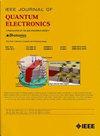基于光子神经形态物理不可克隆函数的伪随机发生器
IF 2.1
3区 工程技术
Q3 ENGINEERING, ELECTRICAL & ELECTRONIC
引用次数: 0
摘要
在这项工作中,我们提供了有关配置为物理不可克隆函数的硅衬底光子神经形态电路的数值结果。所提出的方案增强了作为非常规确定性伪随机数发生器运行的能力,适用于密码应用,减轻了在非易失性数字媒体中存储密钥的需要。所提出的光子神经形态方案能够提供与 NIST 测试兼容的数字,其假正/假负概率极低,低于 10-14。所提出的方案可同时用作机器学习应用的集成光子加速器和硬件信任根,因此具有多功能能力。本文章由计算机程序翻译,如有差异,请以英文原文为准。
Pseudo-Random Generator Based on a Photonic Neuromorphic Physical Unclonable Function
In this work we provide numerical results concerning a silicon-on-insulator photonic neuromorphic circuit configured as a physical unclonable function. The proposed scheme is enhanced with the capability to be operated as an unconventional deterministic pseudo-random number generator, suitable for cryptographic applications that alleviates the need for key storage in non-volatile digital media. The proposed photonic neuromorphic scheme is able to offer NIST test compatible numbers with an extremely low false positive/negative probability below 10-14. The proposed scheme offers multi-functional capabilities due to the fact that it can be simultaneously used as an integrated photonic accelerator for machine-learning applications and as a hardware root of trust.
求助全文
通过发布文献求助,成功后即可免费获取论文全文。
去求助
来源期刊

IEEE Journal of Quantum Electronics
工程技术-工程:电子与电气
CiteScore
4.70
自引率
4.00%
发文量
99
审稿时长
3.0 months
期刊介绍:
The IEEE Journal of Quantum Electronics is dedicated to the publication of manuscripts reporting novel experimental or theoretical results in the broad field of the science and technology of quantum electronics. The Journal comprises original contributions, both regular papers and letters, describing significant advances in the understanding of quantum electronics phenomena or the demonstration of new devices, systems, or applications. Manuscripts reporting new developments in systems and applications must emphasize quantum electronics principles or devices. The scope of JQE encompasses the generation, propagation, detection, and application of coherent electromagnetic radiation having wavelengths below one millimeter (i.e., in the submillimeter, infrared, visible, ultraviolet, etc., regions). Whether the focus of a manuscript is a quantum-electronic device or phenomenon, the critical factor in the editorial review of a manuscript is the potential impact of the results presented on continuing research in the field or on advancing the technological base of quantum electronics.
 求助内容:
求助内容: 应助结果提醒方式:
应助结果提醒方式:


